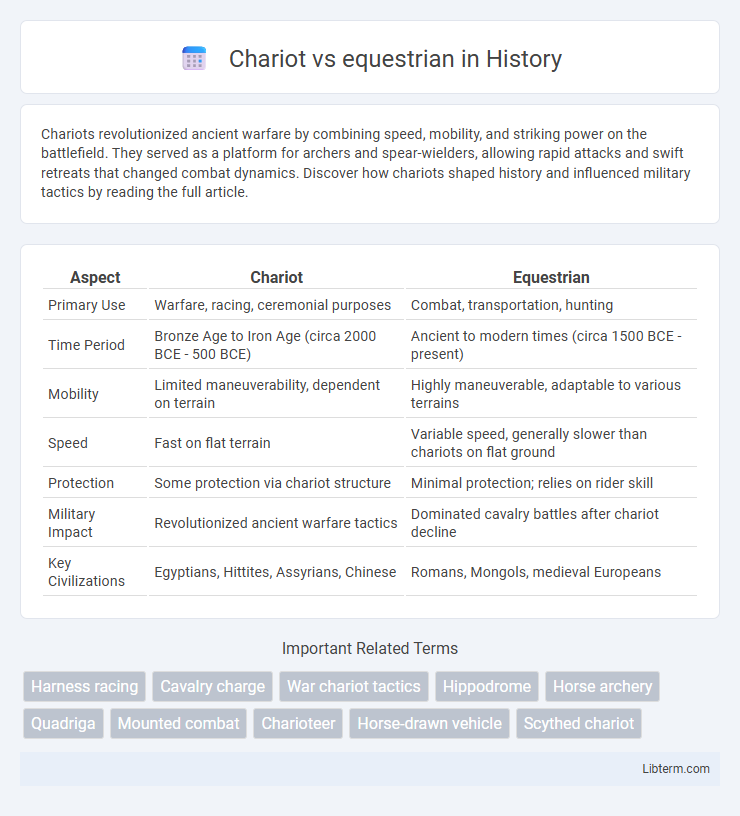Chariots revolutionized ancient warfare by combining speed, mobility, and striking power on the battlefield. They served as a platform for archers and spear-wielders, allowing rapid attacks and swift retreats that changed combat dynamics. Discover how chariots shaped history and influenced military tactics by reading the full article.
Table of Comparison
| Aspect | Chariot | Equestrian |
|---|---|---|
| Primary Use | Warfare, racing, ceremonial purposes | Combat, transportation, hunting |
| Time Period | Bronze Age to Iron Age (circa 2000 BCE - 500 BCE) | Ancient to modern times (circa 1500 BCE - present) |
| Mobility | Limited maneuverability, dependent on terrain | Highly maneuverable, adaptable to various terrains |
| Speed | Fast on flat terrain | Variable speed, generally slower than chariots on flat ground |
| Protection | Some protection via chariot structure | Minimal protection; relies on rider skill |
| Military Impact | Revolutionized ancient warfare tactics | Dominated cavalry battles after chariot decline |
| Key Civilizations | Egyptians, Hittites, Assyrians, Chinese | Romans, Mongols, medieval Europeans |
Introduction: Chariot vs Equestrian
Chariot and equestrian sports both emphasize skillful control of horses but differ fundamentally in their approach and historical context. Chariot racing, originating in ancient civilizations like Rome and Greece, involved teams racing horse-drawn chariots on packed tracks, symbolizing speed and strategic maneuvering. Equestrian sports, encompassing disciplines such as dressage, show jumping, and eventing, focus on the rider's harmony and communication with a single horse, highlighting precision and partnership.
Historical Overview of Chariots and Equestrianism
Chariots originated around 2000 BCE in Mesopotamia, serving as powerful war machines and symbols of status in ancient Egyptian and Hittite civilizations. Equestrianism, dating back to 4000 BCE in the Eurasian steppes, evolved as horseback riding became crucial for hunting, warfare, and transportation. The transition from chariot warfare to cavalry dominance in classical antiquity reflects advancements in horse breeding, saddle technology, and military tactics.
Technological Differences: Design and Function
Chariots featured lightweight, two-wheeled designs optimized for speed and maneuverability, utilizing spoked wheels and iron fittings to reduce weight and enhance durability. Equestrian setups relied on saddle, stirrup, and bridle innovations that improved rider stability, control, and communication with the horse, facilitating more precise maneuvers. The mechanical complexity of chariots contrasted with the biological synergy of mounted riding, reflecting divergent technological approaches to ancient transportation and warfare.
Roles in Warfare: Chariots vs Mounted Cavalry
Chariots in warfare primarily served as mobile archery platforms and command vehicles, offering speed and battlefield control during ancient battles. Mounted cavalry, emerging later, provided greater maneuverability, shock impact through charges, and versatility across varied terrains. The transition from chariots to cavalry marked a strategic evolution, emphasizing individual rider skill and adaptability over the chariot's reliance on complex construction and flat battlefield conditions.
Cultural Significance and Symbolism
Chariots symbolize power, technological advancement, and divine favor in ancient civilizations such as Mesopotamia and Egypt, often associated with warfare, royalty, and ceremonial prestige. Equestrian traditions emphasize skill, nobility, and human mastery over horses, reflecting social status and horsemanship in cultures like medieval Europe and Native American tribes. Both chariots and equestrian practices serve as cultural markers of identity, hierarchy, and spiritual symbolism across diverse historical contexts.
Geographic Dominance and Spread
Chariot warfare dominated regions like Mesopotamia, Egypt, and the Indus Valley around 2000 BCE, enabling rapid military expansion across fertile river valleys and open plains. Equestrian forces gained geographic dominance later, spreading extensively through the Eurasian steppes and influencing the mobility and tactics of nomadic tribes across Central Asia and Eastern Europe. The adaptability of horseback units in varied terrains contributed to their widespread diffusion compared to the more terrain-dependent chariot systems.
Training and Skills Required
Chariot driving demanded intense physical strength, precise coordination, and the ability to maneuver at high speeds in competitive or battle settings, emphasizing stamina and rapid reflexes. Equestrian skills required deep knowledge of horse behavior, balance, and control to perform complex movements such as dressage, jumping, or racing. Both disciplines necessitated rigorous training routines, but charioteers often specialized in teamwork with horses in harness, while equestrians focused on individual horsemanship and nuanced communication with a single horse.
Impact on Ancient Battles and Tactics
Chariot warfare revolutionized ancient battles by enhancing mobility and shock impact, enabling rapid flanking maneuvers and disrupting enemy formations with speed and force. Equestrian forces, characterized by versatile cavalry units, offered greater tactical flexibility, allowing commanders to execute complex battlefield strategies such as skirmishing, reconnaissance, and pursuit. The shift from chariot-dominated engagements to mounted cavalry tactics marked a significant evolution in ancient military doctrine, influencing the rise and fall of empires across Mesopotamia, Egypt, and later classical civilizations.
Evolution and Decline: Why One Surpassed the Other
Chariot racing, prominent in ancient civilizations such as Rome and Greece, evolved from practical military use to popular sport but declined with the fall of those empires and advancements in cavalry tactics. Equestrian sports continued to develop, adapting to changing cultural and technological landscapes, eventually surpassing chariot racing in both prestige and longevity. The agility and versatility of horseback riding offered broader utility and appeal, contributing to its sustained prominence over the obsolete chariot races.
Legacy and Modern Representations
Chariots symbolize ancient power and technological innovation, often depicted in historical reenactments, museums, and classic literature showcasing their strategic role in warfare and transportation. Equestrianism represents enduring human-animal partnership, celebrated through modern sports like dressage and show jumping, embodying grace, skill, and competitive spirit. Both legacies persist in popular culture, with chariots evoking antiquity's grandeur and equestrianism reflecting contemporary athleticism and tradition.
Chariot Infographic

 libterm.com
libterm.com